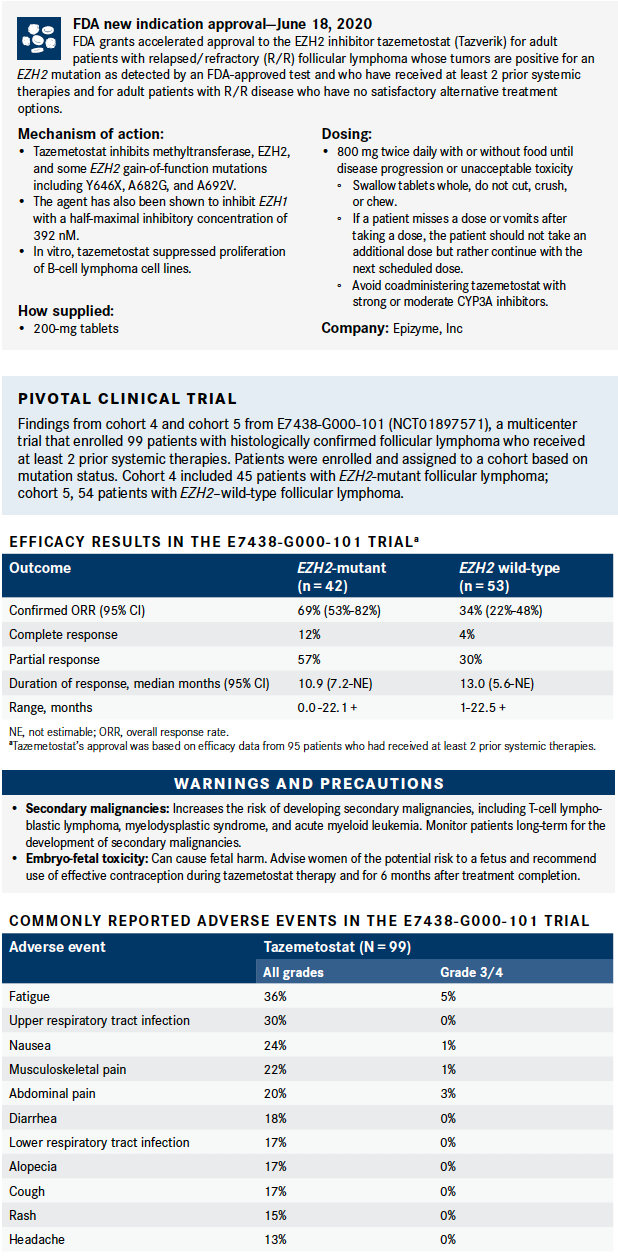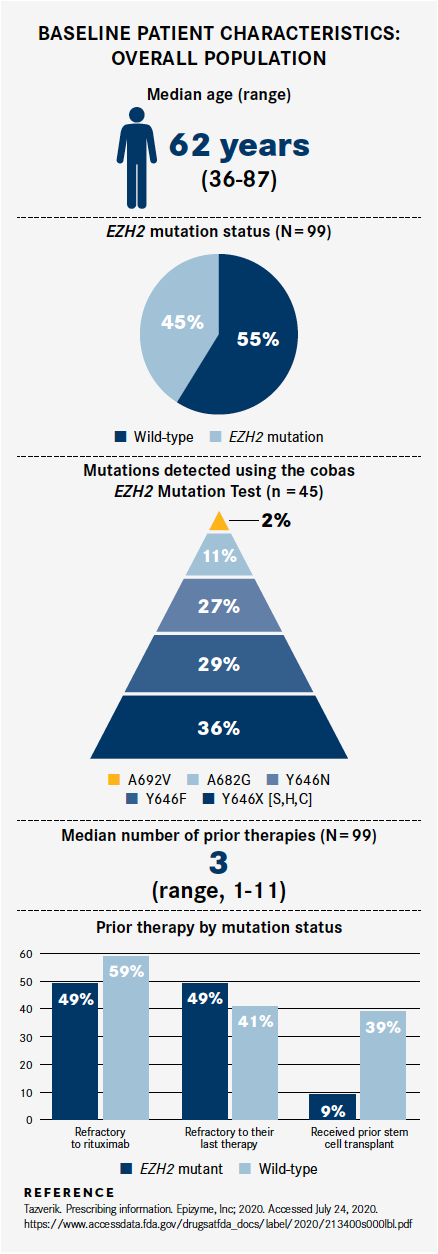Tazemetostat Expands Follicular Lymphoma Tool Kit
The approval of tazemetostat has expanded the portfolio of treatment options for relapsed/refractory follicular lymphoma, a disease for which new agents are needed because patients do not uniformly derive benefit from available therapies.
Tycel J. Phillips, MD

The approval of tazemetostat (Tazverik) has expanded the portfolio of treatment options for relapsed/refractory (R/R) follicular lymphoma (FL), a disease for which new agents are needed because patients do not uniformly derive benefit from available therapies.
On June 18, 2020, the FDA granted an accelerated approval for tazemetostat for 2 distinct populations: Adults with R/R FL whose tumors are positive for an EZH2 mutation as detected by an FDA-approved test and have received at least 2 prior systemic therapies, and adults with R/R disease who have no satisfactory alternative treatment options.1 The drug initially was approved in January 2020 for adult and pediatric patients aged 16 years and older with metastatic or locally advanced epithelioid sarcoma not eligible for complete resection.

The EZH2 inhibitor’s FL approval is based on overall response rate (ORR) and duration of response (DOR) data from cohort 4 and cohort 5 of the phase 1/2 E7438-G000-101 trial (NCT01897571) in patients with histologically confirmed FL who received a minimum of 2 prior systemic therapies. The efficacy cohorts comprised 42 patients with EZH2-mutant disease and 53 patients with EZH2–wildtype FL, respectively.1
In cohort 4, the ORR was 69% (95% CI, 53%-82%), with a 12% complete response rate and a 57% partial response rate. The median DOR was 10.9 months. In cohort 5, the ORR was 34% (95% CI, 22%-48%), with a 4% complete response rate, a 30% partial response rate, and a median DOR of 13 months.1
Continued approval for the FL indications may be based upon findings from a confirmatory phase 3 trial (NCT04224493) that is comparing tazemetostat in combination with the R2 regimen of rituximab (Rituxan) plus lenalidomide (Revlimid) versus R2 plus placebo in patients with R/R FL who have received at least 1 prior systemic therapy.2 The study, which has an estimated enrollment of 518 patients, will stratify patients based on their EZH2 mutation status.

In an interview with OncLive, Tycel J. Phillips, MD, medical oncologist and principal investigator of the E7438-G000-101 study site at the University of Michigan Rogel Cancer Center in Ann Arbor, discussed the advantages of tazemetostat for patients with FL.
How did responses differ across the EZH2-mutant and wild-type populations?
Phillips: There was a very high ORR in patients with EZH2-mutant disease. The DOR in these patients was a bit shorter than what people would anticipate, but I think there are 2 parts to that, one being the slow enrollment in the EZH2-mutant cohort, which is still not as mature as the wild-type cohort.
Also, patients with EZH2-mutant disease were noted to have mild progression, which would have been pseudo-progression in some cases given that on subsequent scans, these same areas demonstrated interval reduction with further treatment. These patients were originally allowed to remain on study [because] they were still deriving benefit from tazemetostat. [However,] these patients were unfortunately impacted by [a temporary] FDA hold in 2018 and removed from the trial at the time of the hold. At our site, we had a few patients like this who were still benefiting from the trial, but were forced to come off study.
Another takeaway from this study is that the drug was also effective in patients with wild-type disease, who did have responses, although these responses were not as high as those in patients with the mutation. The DOR for patients with wildtype disease was fairly reasonable and comparable to some of the other agents that are currently approved in the third-line setting and beyond for follicular lymphoma.
Please describe tazemetostat’s safety profile.
Overall, tazemetostat was well tolerated. In the patients treated [at our site], the most commonly reported AEs [adverse events] were cytopenia (mainly thrombocytopenia) and gastrointestinal symptoms. The gastrointestinal symptoms are fairly common with most oral agents, but none of the cases were severe. Similarly, the cytopenias noted were mild. There were very few grade 3 or 4 AEs that led to treatment discontinuation.
In the third-line setting and beyond, tazemetostat has a very good safety profile compared with other agents approved in this setting.
We did not observe transaminitis, colitis, or infections that you would expect with PI3K delta inhibitors, [or] the rash or thrombosis that you see with lenalidomide. Overall, the agent’s manageable safety profile probably portends a positive future for tazemetostat to be combined with other agents.
How does tazemetostat compare with available treatment options?
In the second-line setting for patients with an EZH2 mutation, I think the tazemetostat data speak for themselves: The agent is safe, effective, and tolerable.
For patients who harbor the mutation, tazemetostat is a very good second-line choice and should strongly be considered as the treatment of choice compared with other agents, pending further maturity of the data.
For the patients with wild-type disease, their age, prior treatment history, comorbidities, and the AE profiles of the agents being considered as potential treatment interventions will impact where tazemetostat fits in the treatment paradigm, since the response rate is not as high as what has been reported with the delta inhibitors, which are the agents currently approved in the third-line setting. The long-term tolerability is probably better with tazemetostat, but this will be further clarified with time.
What are the next steps for this agent?
As far as the future of tazemetostat, time will provide further safety and efficacy data as the study continues to mature. Additionally, we can look forward to the future of studies combining the drug with other agents. [Epizyme, Inc] is currently looking to explore this agent in combination with lenalidomide. We can expect other combination studies in patients with relapsed/refractory follicular lymphoma in the future. There is also no reason that you cannot potentially see tazemetostat combined with chemotherapy at some point in the future in patients with untreated disease.
References
1. FDA granted accelerated approval to tazemetostat for follicular lymphoma. News release. FDA. June 18, 2020. Accessed July 14, 2020. bit.ly/2DEG2Z7
2. Epizyme announces U.S. FDA accelerated approval of TAZVERIK (tazemetostat) for relapsed/refractory follicular lymphoma. News release. Epizyme, Inc; June 18, 2020. Accessed August 12, 2020. bit.ly/3kCXnCQ




